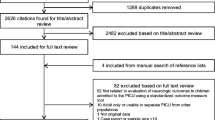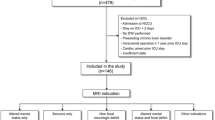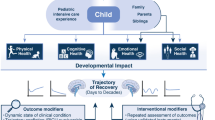Abstract
Encephalopathy and other neurologic morbidities are common in critical illness, sepsis, and prolonged mechanical ventilation. We assessed structural changes on brain imaging and neuropsychological outcomes in critically ill patients who developed neurological changes during their intensive care unit (ICU) stay. Patients who underwent brain imaging for neurological changes were included in the study. Medical, neuroradiological, and outcome data were obtained from patient medical records. Sixty-four patients underwent brain imaging for neurological changes. Forty-one (64%) patients had abnormalities on brain imaging. There were no differences for age, hospital length of stay, ICU length of stay, duration of mechanical ventilation or APACHE II scores for patients with normal compared to abnormal brain imaging. Cognitive impairments occurred in 48% of survivors and 6% developed psychiatric disorders. Our study demonstrates that abnormalities on brain imaging are common in critically ill patients. We also confirm previous findings that survivors of critical illness have cognitive impairments post-ICU discharge. This study further illustrates the adverse effects of critical illness on the brain and highlights the need for additional research in this emerging area.




Similar content being viewed by others
References
Al-Saidi, F., McAndrews, M. P., Cheung, A. M., Tansey, C. M., Matte-Martyn, A., Diaz-Granados, N., et al. (2003). Neuropsychological sequelae in ARDS survivors. American Journal of Respiratory and Critical Care Medicine, 167(7), A737.
Angus, D. C., Barnato, A. E., Linde-Zwirble, W. T., Weissfeld, L. A., Watson, R. S., Rickert, T., et al. (2004). Use of intensive care at the end of life in the United States: an epidemiologic study. Critical Care Medicine, 32(3), 638–643.
Bachevalier, J., & Meunier, M. (1996). Cerebral ischemia: are the memory deficits associated with hippocampal cell loss? Hippocampus, 6(5), 553–560.
Bayley, P. J., Gold, J. J., Hopkins, R. O., & Squire, L. R. (2005). The neuroanatomy of remote memory. Neuron, 46(5), 799–810.
Belet, N., Belet, L., Incesu, L., Uysal, S., Oszinal, S., Keskin, T., et al. (2004). Hypoxic-ischemic encephalopathy: correlation of serial MRI and outcome. Pediatric Neurology, 31(4), 267–274.
Blatter, D. D., Bigler, E. D., Gale, S. D., Johnson, S. C., Anderson, C. V., Burnett, B. M., et al. (1995). Quantitative volumetric analysis of brain MR: normative database spanning 5 decades of life. AJNR. American Journal of Neuroradiology, 16(2), 241–251.
Bradley, W., Waluch, V., Brant-Zawadzki, M., Vadley, R., & Wycoff, R. (1984). Patchy periventricular white matter lesions in the elderly: a common observation during NMR imaging. Noninvasive Medical Imaging, 1, 35–41.
Breteler, M. M. B., van Swieten, J. C., Bots, M. L., Grobbee, D. E., Claus, J. J., van den Hout, J. H. W., et al. (1994). Cerebral white matter lesions, vascular risk factors, and cognitive function in a population-based study: the Rotterdam study. Neurology, 44, 1246–1252.
Caine, D., & Watson, J. D. (2000). Neuropsychological and neuropathological sequelae of cerebral anoxia: a critical review. Journal of the International Neuropsychological Society, 6(1), 86–99.
Christie, J. D., Biester, R. C., Taichman, D. B., Shull, W. H., Jr., Hansen-Flaschen, J., Shea, J. A., et al. (2006). Formation and validation of a telephone battery to assess cognitive function in acute respiratory distress syndrome survivors. Journal of Critical Care, 21(2), 125–132.
Davydow, D. S., Desai, S. V., Needham, D. M., & Bienvenu, O. J. (2008). Psychiatric morbidity in survivors of the acute respiratory distress syndrome: a systematic review. Psychosomatic Medicine, 70(4), 512–519.
de Groot, J. C., de Leeuw, F., Oudkerk, M., van Gijn, J., Hofman, A., Jolles, J., et al. (2000). Cerebral white matter lesions and cognitive function: the Rotterdam scan study. Annals of Neurology, 47, 145–151.
Ellwood, J. L., Moodley, J., & Corr, P. (1998). Cerebral magnetic resonance imaging in eclampsia: a series of 12 cases. Journal of Obstetrics and Gynaecology, 18(5), 412–418.
Fukushima, M., Kobayashi, T., Kubo, K., Yoshimura, K., & Shibamoto, T. (1988). A case of high altitude pulmonary edema followed by brain computerized tomography and electroencephalogram. Aviation, Space, and Environmental Medicine, 59(11 Pt 1), 1076–1079.
Gale, S. D., & Hopkins, R. O. (2004). Effects of hypoxia on the brain: neuroimaging and neuropsychological findings following carbon monoxide poisoning and obstructive sleep apnea. Journal of the International Neuropsychological Society, 10(1), 60–71.
Gordon, N. (1980). Apparent cerebral atrophy in patients on treatment with steroids. Developmental Medicine and Child Neurology, 22(4), 502–506.
Greenaway, M. C., Lacritz, L. H., Binegar, D., Weiner, M. F., Lipton, A., & Munro Cullum, C. (2006). Patterns of verbal memory performance in mild cognitive impairment, Alzheimer disease, and normal aging. Cognitive and Behavioral Neurology, 19(2), 79–84.
Gunning-Dixon, F. M., & Raz, N. (2000). The cognitive correlates of white matter abnormalities in normal aging: a quantitative review. Neuropsychology, 14(2), 224–232.
Hirono, N., Kitagaki, H., Kazui, H., Hashimoto, M., & Mori, E. (2000). Impact of white matter changes on clinical manifestation of Alzheimer’s disease: a quantitative study. Stroke, 31(9), 2182–2188.
Hopkins, R. O., & Jackson, J. C. (2006). Long-term neurocognitive function after critical illness. Chest, 130(3), 869–878.
Hopkins, R. O., Weaver, L. K., Pope, D., Orme, J. F., Jr., Bigler, E. D., & Larson-Lohr, V. (1999). Neuropsychological sequelae and impaired health status in survivors of severe acute respiratory distress syndrome. American Journal of Respiratory and Critical Care Medicine, 160(1), 50–56.
Hopkins, R. O., Waldram, K., & Kesner, R. P. (2004a). Sequences assessed by declarative and procedural tests of memory in amnesic patients with hippocampal damage. Neuropsychologia, 42(14), 1877–1886.
Hopkins, R. O., Weaver, L. K., Chan, K. J., & Orme, J. F., Jr. (2004b). Quality of life, emotional, and cognitive function following acute respiratory distress syndrome. Journal of the International Neuropsychological Society, 10(7), 1005–1017.
Hopkins, R. O., Tate, D. F., & Bigler, E. D. (2005a). Anoxic versus traumatic brain injury: amount of tissue loss, not etiology, alters cognitive and emotional function. Neuropsychology, 19(2), 233–242.
Hopkins, R. O., Weaver, L. K., Collingridge, D., Parkinson, R. B., Chan, K. J., & Orme, J. F., Jr. (2005b). Two-year cognitive, emotional, and quality-of-life outcomes in acute respiratory distress syndrome. American Journal of Respiratory and Critical Care Medicine, 171(4), 340–347.
Hopkins, R. O., Beck, C. J., Burnett, D. L., Weaver, L. K., Victoroff, J., & Bigler, E. D. (2006). Prevalence of white matter hyperintensities in a young healthy population. Journal of Neuroimaging, 16(3), 243–251.
Howell, D. C. (2002). Statistical methods for psychology (5th ed.). Pacific Grove: Duxbury.
Jackson, A. C., Gilbert, J. J., Young, G. B., & Bolton, C. F. (1985). The encephalopathy of sepsis. Canadian Journal of Neurological Sciences, 12(4), 303–307.
Jackson, J. C., Hart, R. P., Gordon, S. M., Shintani, A., Truman, B., May, L., et al. (2003). Six-month neuropsychological outcome of medical intensive care unit patients. Critical Care Medicine, 31(4), 1226–1234.
Jackson, J. C., Hopkins, R. O., Miller, R. R., Gordon, S. M., Wheeler, A. P., Thomason, J. W. W., et al. (2009). Acute respiratory distress syndrome, sepsis, and cognitive decline: a review and case study. [in press]. Southern Medical Journal.
Katzman, G. L., Dagher, A. P., & Patronas, N. J. (1999). Incidental findings on brain magnetic resonance imaging from 1000 asymptomatic volunteers. Journal of the American Medical Association, 282(1), 36–39.
Knaus, W. A., Draper, E. A., Wagner, D. P., & Zimmerman, J. E. (1985). APACHE II: a severity of disease classification system. Critical Care Medicine, 13(10), 818–829.
Kress, J. P., Pohlman, A. S., O’Connor, M. F., & Hall, J. B. (2000). Daily interruption of sedative infusions in critically ill patients undergoing mechanical ventilation. New England Journal of Medicine, 342(20), 1471–1477.
Lagenstein, I., Kuhne, D., Sternowsky, H. J., & Rothe, M. (1979). Computerized cranial transverse axial tomography (CTAT) in 145 patients with primary and secondary generalized epilepsies. West syndrome, myoclonic-astatic petit mal, absence epilepsy. Neuropadiatrie, 10(1), 15–28.
Lerner, D. M., & Rosenstein, D. L. (2000). Neuroimaging in delirium and related conditions. Seminars in Clinical Neuropsychiatry, 5(2), 98–112.
Manns, J. R., Hopkins, R. O., Reed, J. M., Kitchener, E. G., & Squire, L. R. (2003). Recognition memory and the human hippocampus. Neuron, 37(1), 171–180.
Marquis, K., Curtis, J., Caldwell, E., Davidson, T., Davis, J., Sanchez, P., et al. (2000). Neuropsychological sequelae in survivors of ARDS compared with critically ill control patients. American Journal of Respiratory and Critical Care Medicine, 161, A383.
Meguro, K., Hatazawa, J., Yamaguchi, T., Itoh, M., Matsuzawa, T., Ono, S., et al. (1990). Cerebral circulation and oxygen metabolism associated with subclinical periventricular hyperintensity as shown by magnetic resonance imaging. Annals of Neurology, 28(3), 378–383.
Oniki, T. A., & Gardner, R. M. (1993). Computerized detection of arterial oxygen desaturations in an intensive care unit. Proceedings of the Annual Symposium on Computer Applications in Medical Care, 356–360.
Orme, J. F., Jr., Romney, J. S., Hopkins, R. O., Pope, D., Chan, K. J., Thomsen, G., et al. (2003). Pulmonary function and health-related quality of life in survivors of acute respiratory distress syndrome. American Journal of Respiratory and Critical Care Medicine, 167(5), 690–694.
Ostrov, S. G., Quencer, R. M., Gaylis, N. B., & Altman, R. D. (1982). Cerebral atrophy in systemic lupus erythematosus: steroid- or disease-induced phenomenon? American Journal of Neuroradiology, 3(1), 21–23.
Parkinson, R. B., Hopkins, R. O., Cleavinger, H. B., Weaver, L. K., Victoroff, J., Foley, J. F., et al. (2002). White matter hyperintensities and neuropsychological outcome following carbon monoxide poisoning. Neurology, 58(10), 1525–1532.
Rothenhäusler, H. B., Ehrentraut, S., Stoll, C., Schelling, G., & Kapfhammer, H. P. (2001). The relationship between cognitive performance and employment and health status in long-term survivors of the acute respiratory distress syndrome: results of an exploratory study. General Hospital Psychiatry, 23(2), 90–96.
Russell, J. A., Singer, J., Bernard, G. R., Wheeler, A., Fulkerson, W., Hudson, L., et al. (2000). Changing pattern of organ dysfunction in early human sepsis is related to mortality. Critical Care Medicine, 28(10), 3405–3411.
Schmidt, R., Fazekas, F., Kleinert, G., Offenbacher, H., Gindl, K., Payer, F., et al. (1992). Magnetic resonance imaging signal hyperintensities in the deep and subcortical white matter. A comparative study between stroke patients and normal volunteers. Archives of Neurology, 49(8), 825–827.
Suchyta, M. R., Hopkins, R. O., White, J., Jephson, A., & Morris, A. H. (2004). The incidence of cognitive dysfunction after ARDS. American Journal of Respiratory and Critical Care Medicine, 169(7), A18.
Suchyta, M. R., Jephson, A., & Hopkins, R. O. (2005). Brain MR and CT findings associated with critical illness. Proceedings of the American Thoracic Society, Abstracts, 2, A426.
Sukantarat, K., Williamson, R., Burgess, P., & Brett, S. (2004). Dysexecutive syndrome after critical illness [Abstract]. American Journal of Respiratory and Critical Care Medicine, 169, A628.
Sundgren, P. C., Reinstrup, P., Romner, B., Holtas, S., & Maly, P. (2002). Value of conventional, and diffusion- and perfusion weighted MRI in the management of patients with unclear cerebral pathology, admitted to the intensive care unit. Neuroradiology, 44(8), 674–680.
Tuor, U. I., Kozlowski, P., Del Bigio, M. R., Ramjiawan, B., Su, S., Malisza, K., et al. (1998). Diffusion- and T2-weighted increases in magnetic resonance images of immature brain during hypoxia-ischemia: transient reversal posthypoxia. Experimental Neurology, 150(2), 321–328.
van Swieten, J. C., Geyskes, G. G., Derix, M. M., Peeck, B. M., Ramos, L. M., van Latum, J. C., et al. (1991). Hypertension in the elderly is associated with white matter lesions and cognitive decline. Annals of Neurology, 30(6), 825–830.
Walters, R. J., Fox, N. C., Schott, J. M., Crum, W. R., Stevens, J. M., Rossor, M. N., et al. (2003). Transient ischaemic attacks are associated with increased rates of global cerebral atrophy. Journal of Neurology, Neurosurgery and Psychiatry, 74(2), 213–216.
Weinert, C. R., Gross, C. R., Kangas, J. R., Bury, C. L., & Marinelli, W. A. (1997). Health-related quality of life after acute lung injury. American Journal of Respiratory and Critical Care Medicine, 156(4 Pt 1), 1120–1128.
Yaari, R., & Corey-Bloom, J. (2007). Alzheimer’s disease. Seminars in Neurology, 27(1), 32–41.
Yokota, H., Ogawa, S., Kurokawa, A., & Yamamoto, Y. (2003). Regional cerebral blood flow in delirium patients. Psychiatry and Clinical Neurosciences, 57(3), 337–339.
Young, B. (1995). Neurologic complications of systemic critical illness. Neurologic Clinics, 13, 645–658.
Young, G. B., Bolton, C. F., Austin, T. W., Archibald, Y. M., Gonder, J., & Wells, G. A. (1990). The encephalopathy associated with septic illness. Clinical and investigative medicine. Medecine Clinique et Experimentale, 13(6), 297–304.
Zunker, P., Golombeck, K., Brossmann, J., Georgiadis, D., & Deuschl, G. (2002). Post-partum cerebral angiopathy: repetitive TCD, MRI, MRA, and EEG examinations. Neurological Research, 24(6), 570–572.
Acknowledgements
We would like to thank Colin Key, PhD for consultation on the statistical analysis.
Author information
Authors and Affiliations
Corresponding author
Additional information
There was no funding from any source for this research.
Rights and permissions
About this article
Cite this article
Suchyta, M.R., Jephson, A. & Hopkins, R.O. Neurologic Changes during Critical Illness: Brain Imaging Findings and Neurobehavioral Outcomes. Brain Imaging and Behavior 4, 22–34 (2010). https://doi.org/10.1007/s11682-009-9082-3
Received:
Accepted:
Published:
Issue Date:
DOI: https://doi.org/10.1007/s11682-009-9082-3




